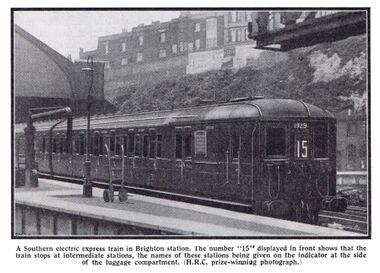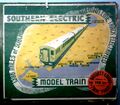Category:Electrical Multiple Units (EMUs)
1936: Southern electric train in Brighton Station [image info]
1939: Bassett-Lowke Trix Twin (TTR) box set, produced with the cooperation of Southern Railway to promote the new trains [image info]
1939: TTR catalogue image [image info]
1963: Hornby Dublo 4150, SR Driver Trailer [image info]
An Electrical Multiple Unit (EMU) is a train with an electric motorised carriage with cab at each end, which allows units to be stacked to produce longer trains. In the UK they are historically associated with the old Southern Railway, which pioneered main-line electrification and the use of standardised three-car EMUs in the early 1930s (normally painted in Southern green).
... Throughout the Southern electrification area "multiple-unit" electric trains are in use. The two methods of working electric services are, first, to use independent electric locomotives, and second, to equip each "unit" of rolling stock in such a way that it can propel itself. The former has the advantage that trains made up of ordinary passenger stock, and also freight trains can be worked over electrified lines. In the latter type each train is a self-contained unit, requiring the attachment of no locomotive, nor the running of the locomotive round at the terminus before returning.
For suburban service, multiple-unit trains are in almost universal use; the Southern units are of three cars, a third-class motor and brake-coach at each end, and a composite first and third-class coach in the centre. Each motor-coach is provided with motor-driving equipment and brushes for picking up the current from the live rail; it also has driving compartments at each end, but at whichever end the driver may be working, he controls the working of both motors. At "rush hours" two units are coupled together, making six cars, driven by motors at four different points along the length of the train; but all the motors are still under the control of the one driver; hence the name "multiple unit". At the busiest times, two third-class "trailer" coaches are attached, between the two motor-driven units, to provide additional accommodation, making eight cars in all. ...
Although much of the stock used in the suburban electric services (trailer cars in particular) was adapted from the coaches in use in steam days, all of the rolling-stock on the long-distance service has been specially built for the electrification. For the extension to Brighton and Worthing alone 285 new cars were built, including 38 Pullman cars. ...
— , -, , Electric Power on the Grand Scale, , Railway Wonders of the World, , 1935
External links
- 4mm scale mass-produced ready to run EMUs - Early Models (southernelectric.org.uk)
- EPB Preservation Group (epbpg.co.uk)
- Southern Electric Multiple Units (rail.felgall.com)
- The Southern Suburban Electric Network, Suburban Electric Railway Association (emus.co.uk)
- Southern Electric Traction Group (setg.org.uk)
- British electrical multiple units (wikipedia.org)
Subcategories
This category has the following 2 subcategories, out of 2 total.
B
H
- Hugar Railways (2 P)
Pages in category ‘Electrical Multiple Units (EMUs)’
The following 6 pages are in this category, out of 6 total.
S
Media in category ‘Electrical Multiple Units (EMUs)’
The following 8 files are in this category, out of 8 total.
- Electric Driving Trailer Coach S77511, SR, Hornby-Dublo 4150 (DubloCat 1963).jpg 1,694 × 692; 234 KB
- Southern electric three-coach train (TTRcat 1939).jpg 1,600 × 1,200; 309 KB
- Southern Electric train in Brighton Station (MM 1936-05).jpg 1,800 × 1,293; 700 KB
- Southern Electric train set (BL-TTRcat 1938).jpg 1,332 × 2,000; 701 KB
- SR Electric Motor Coach (Milbro 1930).jpg 2,729 × 2,272; 1.1 MB
- TTR catalogue green Southern electric 1939.jpg 1,025 × 1,285; 235 KB
- TTR green Southern electric train set (1939).jpg 1,152 × 1,011; 173 KB













